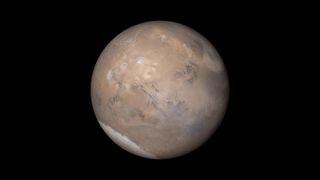Mars meteorites reveal clues about what lies within the Red Planet
Did we mention the meteorites indicate a new type of rock, too?

One day, we'll bring samples home from Mars — but, until then, we have to make do with what we've got. Fortunately, we actually have some Martian material to work with, thanks to meteorites from Mars that crashed into Earth.
Sure enough, scientists with the University of California, San Diego's Scripps Institution of Oceanography are studying these meteorites, and have indeed gained insight into the early formation of the Red Planet. Specifically, they've gleaned information about the structure of Mars' crust and mantle. The meteorites indicate Mars has an atmospherically altered upper crust as well as a complex deeper crust; they also suggest it has a mantle from which plumes emerge through the crust to produce a specific type of volcano. The meteorites have also indicated that Mars has discernible reservoirs throughout its internal structure.
"Martian meteorites are the only physical materials we have available from Mars," Scripps Oceanography geologist James Day, lead author of a study on the research, said in a statement. "They enable us to make precise and accurate measurements and then quantify processes that occurred within Mars and close to the Martian surface. They provide direct information on Mars’ composition that can ground truth mission science, like the ongoing Perseverance rover operations taking place there."
Day's team studied two specific types of Martian meteorites: nakhlites and chassignites. These meteorites formed in a Martian volcanic system some 1.3 billion years ago, were ejected from the planet some 11 million years ago following a meteor impact, then crashed into Earth. They've since been found all around the world.
"By determining that nakhlites and chassignites are from the same volcanic system, and that they interacted with Martian crust that was altered by atmospheric interactions, we can identify a new rock type on Mars," Day said.
Related: The 'hole' on Mars making headlines could be crucial to Red Planet exploration
Day finds the similarities and differences between volcanism on Mars and Earth to be remarkable. "On the one hand, nakhlites and chassignites formed in similar ways to recent volcanism in places like Oahu in Hawaii. There, newly formed volcanoes press down on the mantle generating tectonic forces that produce further volcanism," he said. "On the other hand, the reservoirs in Mars are extremely ancient, separating from one another shortly after the Red planet formed. On Earth, plate tectonics has helped to remix reservoirs back together over time."
Get the Space.com Newsletter
Breaking space news, the latest updates on rocket launches, skywatching events and more!
So, we'll ask the question you're probably wondering: How do scientists know that these meteorites came from Mars? For one thing, we can tell that they're very young, geologically speaking, so they must've originated from a recently active planet. But perhaps more importantly, the meteorites contain the composition of the Martian atmosphere, which was measured by NASA's Viking landers in the 1970s. And until we're able to bring back samples from the Martian surface, we'll have to work with the next best thing.
A paper about the team's work was published on May 31 in the journal Science Advances.
Join our Space Forums to keep talking space on the latest missions, night sky and more! And if you have a news tip, correction or comment, let us know at: community@space.com.

Space.com contributing writer Stefanie Waldek is a self-taught space nerd and aviation geek who is passionate about all things spaceflight and astronomy. With a background in travel and design journalism, as well as a Bachelor of Arts degree from New York University, she specializes in the budding space tourism industry and Earth-based astrotourism. In her free time, you can find her watching rocket launches or looking up at the stars, wondering what is out there. Learn more about her work at www.stefaniewaldek.com.